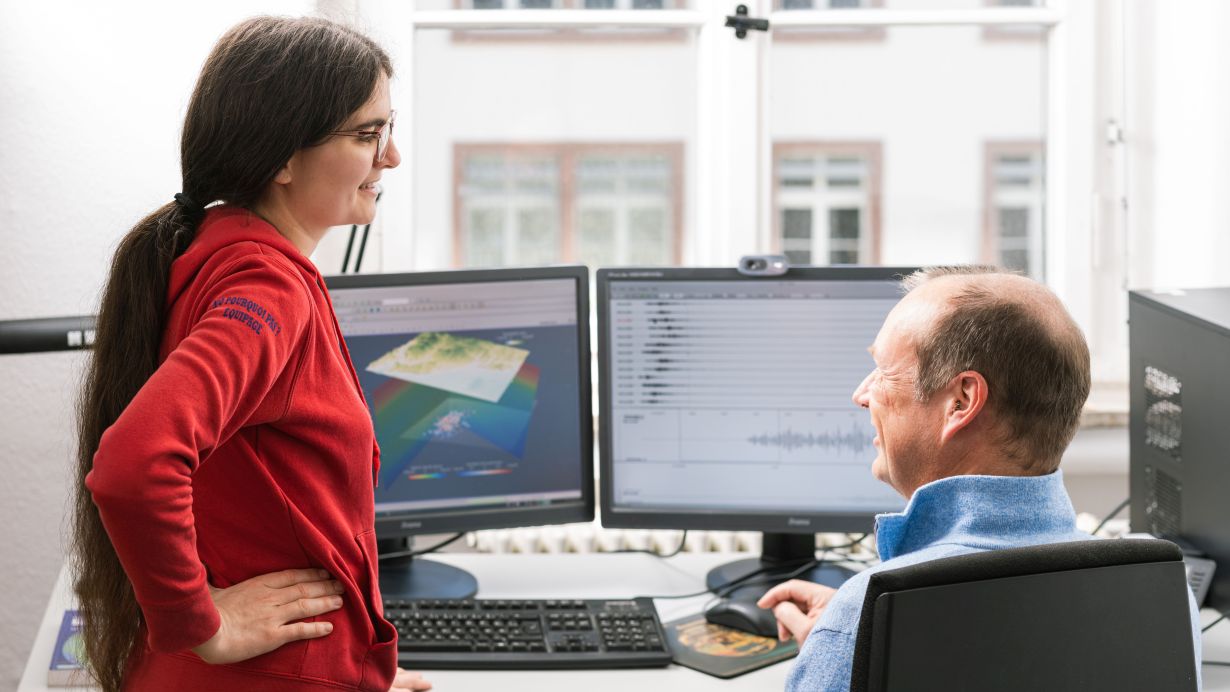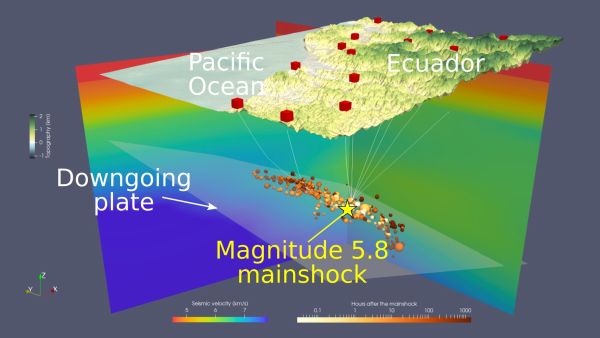
When one tectonic plate slides underneath another tectonic plate, strong earthquakes result rather frequently. The severe earthquake off the coast of Taiwan in early April 2024 also took place at such a subduction interface. A study of researchers of Karlsruhe Institute of Technology (KIT) and partners now suggests that earthquakes of this type may be a series of ruptures in a multi-fault network rather than a single rupture. The corresponding evidence was found by the team using a very dense network of seismometers in a comparable subduction zone in Ecuador. Using artificial intelligence (AI), the researchers generated a three-dimensional model of seismic activity. They report in Nature (DOI: 10.1038/s41586-024-07245-y).
Wherever tectonic plates collide with each other, stress results. This particularly happens along subduction zones, in which one tectonic plate slides underneath another one. When they detach, extremely strong earthquakes may result. A hotspot of such incidents is the so-called Pacific Ring of Fire. Shaped like a horseshoe, it extends from the West Coast of the American continent to Japan to the Philippines. Here, about 90 percent of all earthquakes worldwide happen and threaten megacities like Tokyo or Jakarta. To better estimate the effects of such earthquakes on humans and the environment, researchers of KIT and their partners from the Helmholtz Centre Potsdam - German Research Centre for Geosciences (GFZ), Escuela Politécnica Nacional (EPN) in Quito, and the Laboratoire Géoazur in Valbonne thoroughly studied seismic activity in a subduction zone in Ecuador and obtained surprising findings. "We found evidence that the concept of stress being relieved by a single major earthquake along a single fracture surface may be obsolete," says Professor Andreas Rietbrock from KIT's Geophysical Institute (GPI). "Instead, we should rather speak of a multi-fault network, in which several ruptures give rise to a single earthquake."
There Is No One Megafault
While previous studies covered large spaces and time ranges, the researchers now used AI methods, an increased measurement density, and a three-dimensional velocity model to derive a detailed picture of seismicity. The team studied more than 1,500 seismic events in Ecuador between March 12, 2022 and May 26, 2022. "We found that seismicity occurred in a primary region near the main earthquake and in a secondary region near the aftershocks," says Dr. Caroline Chalumeau from GPI, the first author of the study. "Seismicity in the primary region occurred on several different fault planes that were often located on top of each other. At some points, parallel seismically active planes were found. At other points, single seismically active planes were encountered." Parallelism of the earthquakes was not related to a specific depth.
Analysis of the earthquakes in Ecuador also yielded new findings about aftershocks. "We found that aftershocks first occur near the epicenter of the main shock. Then, they gradually spread into other directions," Chalumeau says and concludes that the spreading of aftershocks in the region is controlled mainly by subsequent sliding of the plates.

The graphical representation shows the two tectonic plates. The earthquakes are represented
in the form of spheres. The size reflects the intensity, the color the time of the earthquake.
(Graphics: Caroline Chalumeau, KIT)
Better Understanding Earthquake Risks
"We have to radically change our understanding of severe earthquakes," Rietbrock summarizes. Analysis of seismic activity in Ecuador provided evidence of a network of partly superposed and parallel faults rather than a single main fault in subduction zones. "This finding will influence future modeling of earthquakes and of aseismic slides, i.e. plate movements without earthquakes," Rietbrock says. Better modeling of earthquakes will result in improved forecasts of risks, he expects.
Original Publication
Dr. Caroline Chalumeau, Dr. Hans Argurto-Detzel, Prof. Andreas Rietbrock, Dr. Michael Frietsch, Prof. Onno Oncken, Dr. Monica Segovia, Dr. Audrey Galve: Seismological evidence for a multifault network at the subduction interface. Nature, 2024. DOI: 10.1038/s41586-024-07245-y
Details on the Geophysical Institute (GPI)
Being "The Research University in the Helmholtz Association", KIT creates and imparts knowledge for the society and the environment. It is the objective to make significant contributions to the global challenges in the fields of energy, mobility, and information. For this, about 10,000 employees cooperate in a broad range of disciplines in natural sciences, engineering sciences, economics, and the humanities and social sciences. KIT prepares its 22,800 students for responsible tasks in society, industry, and science by offering research-based study programs. Innovation efforts at KIT build a bridge between important scientific findings and their application for the benefit of society, economic prosperity, and the preservation of our natural basis of life. KIT is one of the German universities of excellence.






